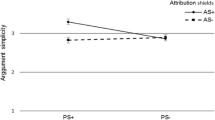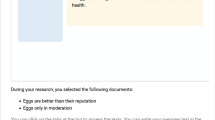Abstract
When reading conflicting science-related texts, readers may attend to cues which allow them to assess plausibility. One such plausibility cue is the use of graphs in the texts, which are regarded as typical of ‘hard science’. The goal of our study was to investigate the effects of the presence of graphs on the perceived plausibility and situation model strength for conflicting science-related texts, while including the influence of readers’ amount of experience with scientific texts and graphs as a potential moderator of these effects. In an experiment mimicking web-based informal learning, 77 university students read texts on controversial scientific issues which were presented with either graphs or tables. Perceived plausibility and situation model strength for each text were assessed immediately after reading; reader variables were assessed several weeks prior to the experiment proper. The results suggest that graphs can indeed serve as plausibility cues and thus boost situation model strength for texts which contain them. This effect was mediated by the perceived plausibility of the information in the texts with graphs. However, whether readers use graphs as plausibility cues in texts with conflicting information seems to depend also on their amount of experience with scientific texts and graphs.



Similar content being viewed by others
References
Amstad, T. (1978). Wie verständlich sind unsere Zeitungen? [How understandable are our newspapers?]. Unpublished doctoral dissertation. Zurich: University of Zürich.
Arsenault, D. J., Smith, L. D., & Beauchamp, E. A. (2006). Visual inscriptions in the scientific hierarchy: Mapping the treasures of science. Scientific Communication, 27, 376–428.
Baddeley, A. D. (1986). Working memory. New York: Oxford University Press.
Baron, R. M., & Kenny, D. A. (1986). The moderator–mediator variable distinction in social psychological research: Conceptual, strategic and statistical considerations. Journal of Personality and Social Psychology, 51, 1173–1182.
Best, R. M., Rowe, M., Ozuru, Y., & McNamara, D. S. (2005). Deep-level comprehension of science texts: The role of the reader and the text. Topics in Language Disorders, 25, 65–83.
Bohner, G., Moskowitz, G., & Chaiken, S. (1995). The interplay of heuristic and systematic processing of social information. European Review of Social Psychology, 6, 33–68.
Bråten, I., Strømsø, H., & Britt, A. (2009). Trust matters: Examining the role of source evaluation in students’ construction of meaning within and across multiple texts. Reading Research Quarterly, 44, 6–28.
Bråten, I., Strømsø, H., & Salmerón, L. (2011). Trust and mistrust when students read multiple information sources about climate change. Learning and Instruction, 21, 180–192.
Britt, M. A., & Aglinskas, C. (2002). Improving students’ ability to identify and use source information. Cognition and Instruction, 20, 485–522.
Britt, M. A., Rouet, J.-F., & Perfetti, C. A. (1999). Content integration and source separation in learning from multiple texts. In S. R. Goldman, A. C. Graesser, & P. van den Broek (Eds.), Narrative comprehension, causality, and coherence: Essays in honor of Tom Trabasso. Mahwah, NJ: Erlbaum.
Bromme, R., Kienhues, D., & Porsch, T. (2010). Who knows what and who can we believe? Epistemological beliefs are beliefs about knowledge (mostly) attained from others. In L. D. Bendixen & F. C. Feucht (Eds.), Personal epistemology in the classroom: Theory, research, and implications for practice (pp. 163–193). Cambridge: Cambridge University Press.
Brown, A. S., & Nix, L. A. (1996). Turning lies into truths: Referential validation of falsehoods. Journal of Experimental Psychology. Learning, Memory, and Cognition, 22, 1088–1100.
Chen, S., & Chaiken, S. (1999). The heuristic-systematic model in its broader context. In S. Chaiken & Y. Trope (Eds.), Dual-process theories in social psychology (pp. 73–96). New York: Guilford.
Cleveland, W. S. (1984). Graphs in scientific publications. The American Statistician, 38, 261–269.
Cohen, J., Cohen, P., West, S. G., & Aiken, L. S. (2003). Applied multiple regression/correlation analysis for the behavioral sciences (3rd ed.). Mawah, NJ: Erlbaum.
Daneman, M. (1991). Working memory as a predictor of verbal fluency. Journal of Psycholinguistic Research, 6, 445–464.
Daneman, M., & Carpenter, P. A. (1980). Individual differences in working memory and reading. Journal of Verbal Learning & Verbal Behavior, 19, 450–466.
Graesser, A. C., & Bertus, E. L. (1998). The construction of causal inferences while reading expository texts on science and technology. Scientific Studies of Reading, 2, 247–269.
Hayes, A. F. (2009). Beyond Baron and Kenny: Statistical mediation analysis in the new millennium. Communication Monographs, 76, 408–420.
Judd, C. M., Kenny, D. A., & McClelland, G. H. (2001). Estimating and testing mediation and moderation in within-subject designs. Psychological Methods, 6, 115–134.
Keil, F. C., Stein, C., Webb, L., Billings, V. D., & Rozenblit, L. (2008). Discerning the division of cognitive labor: An emerging understanding of how knowledge is clustered in other minds. Cognitive Science, 32, 259–300.
Kintsch, W. (1988). The role of knowledge in discourse comprehension: A construction-integration model. Psychological Review, 95, 163–182.
Kosslyn, S. M. (1994). Elements of graph design. New York: W. H. Freeman.
Larkin, J. H., & Simon, H. A. (1987). Why a diagram is (sometimes) worth ten thousand words. Cognitive Science, 11, 65–99.
Latour, B. (1990). Drawing things together. In M. Lynch & S. Woolgar (Eds.), Representation in scientific practice (pp. 19–68). Cambridge: MIT Press.
Lombardi, D., & Sinatra, G. (2012). College students’ perceptions about the plausibility of human-induced climate change. Research in Science Education, 42, 201–217.
Lorch, R. F., Lorch, E. P., & Inman, W. E. (1993). Effects of signaling topic structure on text recall. Journal of Educational Psychology, 85, 281–290.
Meyer, B. J. F. (1975). The organization of prose and its effects on memory. Amsterdam: North Holland.
Muller, D., Judd, C. M., & Yzerbyt, V. Y. (2005). When moderation is mediated and mediation is moderated. Journal of Personality and Social Psychology, 89, 852–863.
Oberauer, K., Süß, H.-M., Schulze, R., Wilhelm, O., & Wittmann, W. W. (2000). Working memory capacity—Facets of a cognitive ability construct. Personality and Individual Differences, 29, 1017–1045.
Perfetti, C. A., Rouet, J.-F., & Britt, M. A. (1999). Toward a theory of documents representation. In H. van Oostendorp & S. Goldman (Eds.), The construction of mental representations during reading (pp. 99–122). Mahwah, NJ: Erlbaum.
Petty, R. E., & Cacioppo, J. T. (1986). Communication and persuasion: Central and peripheral routes to attitude change. New York: Springer.
Petty, R. E., & Wegener, D. T. (1998). Attitude change: Multiple roles for persuasion variables. In D. T. Gilbert, S. T., Fiske, & G. Lindzey (Eds.), Handbook of social psychology (4th ed., Vol. 1, pp. 323–390). New York: McGraw-Hill.
Petty, R. E., & Wegener, D. T. (1999). The elaboration likelihood model: Current status and controversies. In S. Chaiken & Y. Trope (Eds.), Dual-process theories in social psychology (pp. 41–72). New York: Guilford Press.
Porsch, T., & Bromme, R. (2010). Effects of epistemological sensitization on source choices. Instructional Science [Online document]. doi:10.1007/s11251-010-9155-0.
Preacher, K. J., & Hayes, A. F. (2008). Asymptotic and resampling strategies for assessing and comparing indirect effects in multiple mediator models. Behavior Research Methods, 40, 879–891.
Reimer, T., Mata, R., Katsikopoulos, K., & Opwis, K. (2005). On the interplay between heuristic and systematic processes in persuasion. In B. G. Bara, L. Barsalou, & M. Bucciarelli (Eds.), Proceedings of the twenty-seventh annual conference of the cognitive science society (pp. 1833–1838). Mahwah, NJ: Lawrence Erlbaum Associates.
Richter, T. (2011). Cognitive flexibility and epistemic validation in learning from multiple texts. In J. Elen, E. Stahl, R. Bromme, & G. Clarebout (Eds.), Links between beliefs and cognitive flexibility. Berlin: Springer.
Rinck, M. (2008). The interaction of verbal and pictorial information in comprehension and memory. In J.-F. Rouet, W. Schnotz, & R. Lowe (Eds.). Understanding multimedia documents (pp. 185–200). New York: Springer.
Rouet, J.-F., Favart, M., Britt, M. A., & Perfetti, C. A. (1997). Studying and using multiple documents in history: Effects of discipline expertise. Cognition and Instruction, 15, 85–106.
Schmalhofer, F., & Glavanov, D. (1986). Three components of understanding a programmer’s manual: Verbatim, propositional, and situational representations. Journal of Memory and Language, 25, 279–294.
Schnotz, W. (2005). An integrated model of text and picture comprehension. In R. E. Mayer (Ed.), Cambridge handbook of multimedia learning (pp. 49–69). Cambridge: Cambridge University Press.
Schnotz, W., & Bannert, M. (2003). Construction and interference in learning from multiple representations. Learning and Instruction, 13, 141–156.
Schroeder, S., Richter, T., & Hoever, I. (2008). Getting a picture that is both accurate and stable: Situation models and epistemic validation. Journal of Memory and Language, 59, 237–259.
Shrout, P. E., & Bolger, N. (2002). Mediation in experimental and nonexperimental studies: New procedures and recommendations. Psychological Methods, 7, 422–445.
Smith, L. D., Best, L. A., Stubbs, D. A., Archibald, A. B., & Roberson-Nay, R. (2002). Constructing knowledge: The role of graphs and tables in hard and soft psychology. American Psychologist, 57, 749–761.
Smith, L. D., Best, L. A., Stubbs, D. A., Johnston, J., & Archibald, A. B. (2000). Scientific graphs and the hierarchy of the sciences: A Latourian survey of inscription practices. Social Studies of Science, 30, 73–94.
Stadtler, M., & Bromme, R. (2007). Dealing with multiple documents on the WWW: The role of metacognition in the formation of documents models. International Journal of Computer Supported Collaborative Learning, 2, 191–210.
Stadtler, M., Scharrer, L., & Bromme, R. (2011). How reading goals and rhetorical signals influence recipients’ recognition of intertextual conflicts. In L. Carlson, C. Hoelscher, & T. F. Shipley (Eds.), Proceedings of the 33rd annual conference of the cognitive science society (pp. 1346–1351). Austin, TX: Cognitive Science Society.
Tufte, E. R. (1983). The visual display of quantitative information. Cheshire, CN: Graphics Press.
van Dijk, T. A., & Kintsch, W. (1983). Strategies of discourse comprehension. New York: Academic Press.
Vekiri, I. (2002). What is the value of graphical displays in learning? Educational Psychology Review, 14, 261–312.
Wainer, H. (1997). Some multivariate displays for NAEP results. Psychological Methods, 2, 34–63.
Wineburg, S. S. (1991). Historical problem solving: A study of the cognitive processes used in the evaluation of documentary and pictorial evidence. Journal of Educational Psychology, 83, 73–87.
Acknowledgments
This research was supported by grants RI 1100/4-1, RI 1100/4-2 and SCHN 665/5-1 of the Special Priority Program 1409 “Science and the General Public: Understanding Fragile and Conflicting Scientific Evidence” of the German Research Foundation (Deutsche Forschungsgemeinschaft).
Author information
Authors and Affiliations
Corresponding author
Appendix
Rights and permissions
About this article
Cite this article
Isberner, MB., Richter, T., Maier, J. et al. Comprehending conflicting science-related texts: graphs as plausibility cues. Instr Sci 41, 849–872 (2013). https://doi.org/10.1007/s11251-012-9261-2
Received:
Accepted:
Published:
Issue Date:
DOI: https://doi.org/10.1007/s11251-012-9261-2





